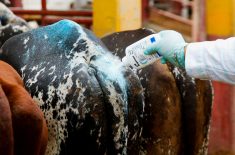Plans to bring beekeepers in on income deferrals available to certain livestock breeders, and to further expand rural broadband, are among the pre-Valentine’s Day candies for farmers in Tuesday’s federal budget.
Federal budgets in recent years have been relatively light on line items meant directly for farmers, as ag program funding is largely locked into five-year federal/provincial/territorial ag policy funding frameworks — for example, Growing Forward 2, covering 2013-18.
Thus, federal Finance Minister Jim Flaherty’s “Economic Action Plan 2014” proposes a few small changes for farmers, mainly in the tax treatment of farms.
Read Also

India slaps 30 per cent import duty on yellow peas
India has imposed a 30 per cent duty on yellow pea imports with a bill of lading date on or after Nov. 1, 2025.
For one, it proposes to expand the income tax rule that allows farmers to defer up to 90 per cent of the income earned when they sell off breeding livestock due to drought, floods or excess moisture conditions in federally-designated dry or waterlogged municipalities or regions.
The deferral rule until now has defined “breeding stock” as cattle, goats and sheep over 12 months of age and kept for breeding, as well as horses over 12 months old and kept for breeding in the commercial production of pregnant mares’ urine (PMU).
Starting in the 2014 tax year, however, the rule will extend to bees, and to all types of horses over 12 months old, that are kept for breeding.
The tax deferral is meant to allow farmers to use the sale proceeds to replenish breeding stock, and is focused on breeding stock “because its sale is akin to disposing of long-term productive assets.”
Allowing a slightly larger group of farmers to defer a portion of such sale revenue from their taxable income until the following year (or the first year in which a region is no longer designated) is expected to cost only “a small amount” of federal revenue in coming tax years.
Land donations
Flaherty also pledged to slightly sweeten the incentive for farmers and other landowners who donate “ecologically sensitive” land to certain registered Canadian charities to protect natural areas.
Generally, charitable donations not claimed in a given tax year can usually be carried forward for up to five years, for use toward a tax credit for individuals or a deduction for corporations.
However, for donations of such land, Flaherty’s budget proposes to double the maximum carry-forward to 10 years — a line item also expected only to reduce federal revenues by a “small amount,” starting in 2013-14.
Farmer/fishers
For farmers who carry on both farming and fishing operations “in a combination,” Tuesday’s budget proposes to simplify tax rules dealing with an individual’s $800,000 Lifetime Capital Gains Exemption (LCGE) and with rollovers of capital gains in intergenerational transfers from a parent to child.
For those purposes, the government proposes to “generally” treat a taxpayer’s combined farming and fishing business as it would treat separate farming and fishing businesses operated by the same taxpayer.
Thus, starting in the 2014 tax year, the new rule would extend eligibility for the intergenerational rollover and the LCGE to an individual’s shares in a corporation or interest in a partnership, where the corporation or partnership carries on both a farming business and a fishing business.
The move, the government said Tuesday, “will ensure consistent treatment for taxpayers who conduct farming and fishing activities in different legal forms.”
Broadband, beer, BSE
Among other moves of interest to farmers and agrifood producers in Tuesday’s budget are:
- establishment of a private-sector steering committee for development of a domestic and international “Made-in-Canada” consumer awareness campaign, with details to be announced “in the coming months;”
- legislation to address “price discrimination” between goods in Canada and the U.S. where not justified by higher operating costs in Canada, and authority for Canada’s Commissioner of Competition to enforce it;
- $205.5 million over five years for the Canadian Food Inspection Agency, Health Canada and the Public Health Agency of Canada, to continue “routine” programming aimed at minimizing likelihood of exposure and spread of bovine spongiform encephalopathy (BSE) within Canada’s cattle herd;
- $153.6 million over five years to “strengthen” the Canadian Food Inspection Agency’s food safety programs;
- $30.7 million over five years, including $5 million in each of 2014-15 and 2015-16, to set up a national Food Safety Information Network, sharing standardized food safety data and analysis and linking provincial and federal food safety authorities and private food testing labs;
- $305 million over five years to “extend and enhance” broadband service to a target speed of five MB/second for up to 280,000 more households in Canada, which would represent “near universal” broadband access;
- updating the compositional standards for beer (and, later, other products) under the Food and Drug Regulations, to better account for new styles of craft beer on the market, citing red tape encountered in the recent attempts to launch Pump House Brewing Co.’s Blueberry Ale and Rickard’s Cardigan Seasonal Spiced Lager;
- a pledge to “enhance funding” for Nutrition North Canada, which subsidizes retailers in 103 remote and isolated communities for the cost of stocking perishable “nutritious” food; and
- adjusting the rate of excise duty on cigarettes, effective after Tuesday, to account for inflation since 2002 (which translates to a duty increase of just over $4 per carton), and automatically adjusting it every five years from now on in keeping with the Consumer Price Index. — AGCanada.com Network












